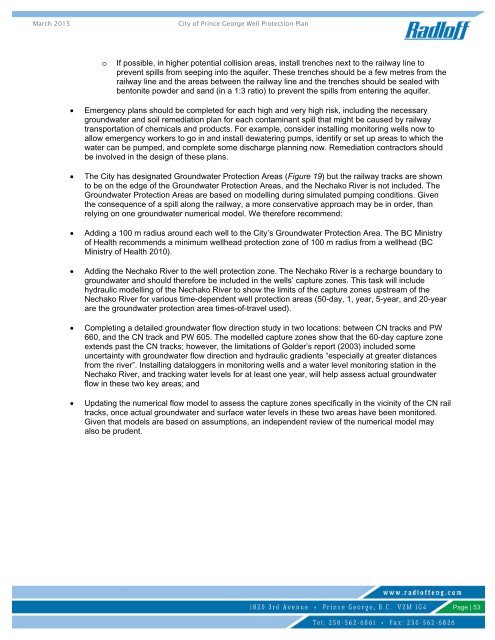CITY OF PRINCE GEORGE WELLS PROTECTION PLAN
Attch_February%2026%202016%20CPG%20wells%20protection%20report%20FINAL%20DRAFT%20V3
Attch_February%2026%202016%20CPG%20wells%20protection%20report%20FINAL%20DRAFT%20V3
You also want an ePaper? Increase the reach of your titles
YUMPU automatically turns print PDFs into web optimized ePapers that Google loves.
March 2015<br />
City of Prince George Well Protection Plan<br />
o<br />
If possible, in higher potential collision areas, install trenches next to the railway line to<br />
prevent spills from seeping into the aquifer. These trenches should be a few metres from the<br />
railway line and the areas between the railway line and the trenches should be sealed with<br />
bentonite powder and sand (in a 1:3 ratio) to prevent the spills from entering the aquifer.<br />
<br />
<br />
<br />
<br />
<br />
<br />
Emergency plans should be completed for each high and very high risk, including the necessary<br />
groundwater and soil remediation plan for each contaminant spill that might be caused by railway<br />
transportation of chemicals and products. For example, consider installing monitoring wells now to<br />
allow emergency workers to go in and install dewatering pumps, identify or set up areas to which the<br />
water can be pumped, and complete some discharge planning now. Remediation contractors should<br />
be involved in the design of these plans.<br />
The City has designated Groundwater Protection Areas (Figure 19) but the railway tracks are shown<br />
to be on the edge of the Groundwater Protection Areas, and the Nechako River is not included. The<br />
Groundwater Protection Areas are based on modelling during simulated pumping conditions. Given<br />
the consequence of a spill along the railway, a more conservative approach may be in order, than<br />
relying on one groundwater numerical model. We therefore recommend:<br />
Adding a 100 m radius around each well to the City’s Groundwater Protection Area. The BC Ministry<br />
of Health recommends a minimum wellhead protection zone of 100 m radius from a wellhead (BC<br />
Ministry of Health 2010).<br />
Adding the Nechako River to the well protection zone. The Nechako River is a recharge boundary to<br />
groundwater and should therefore be included in the wells’ capture zones. This task will include<br />
hydraulic modelling of the Nechako River to show the limits of the capture zones upstream of the<br />
Nechako River for various time-dependent well protection areas (50-day, 1, year, 5-year, and 20-year<br />
are the groundwater protection area times-of-travel used).<br />
Completing a detailed groundwater flow direction study in two locations: between CN tracks and PW<br />
660, and the CN track and PW 605. The modelled capture zones show that the 60-day capture zone<br />
extends past the CN tracks; however, the limitations of Golder’s report (2003) included some<br />
uncertainty with groundwater flow direction and hydraulic gradients “especially at greater distances<br />
from the river”. Installing dataloggers in monitoring wells and a water level monitoring station in the<br />
Nechako River, and tracking water levels for at least one year, will help assess actual groundwater<br />
flow in these two key areas; and<br />
Updating the numerical flow model to assess the capture zones specifically in the vicinity of the CN rail<br />
tracks, once actual groundwater and surface water levels in these two areas have been monitored.<br />
Given that models are based on assumptions, an independent review of the numerical model may<br />
also be prudent.<br />
Page | 53


